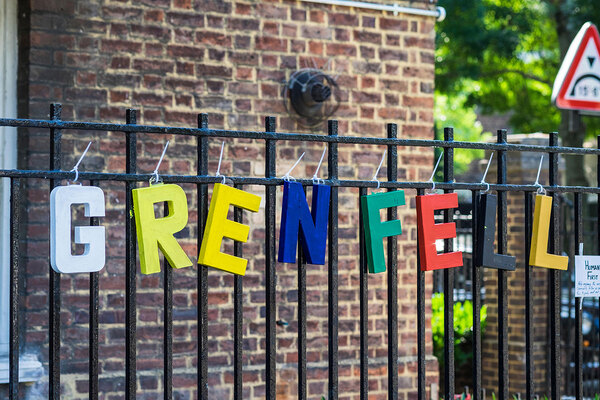You are viewing 1 of your 1 free articles

Foster Evans is now retired, having sat on the board of six housing associations in Scotland from 1978 to 2022
Does Scotland have anything to learn from the English response to the Grenfell fire?
Foster Evans looks at the Scottish housing review post-Grenfell, and what Scotland can learn from the tragedy
On 16 June 2017, 72 people died in the Grenfell Tower fire. The primary cause was the spread of fire caused by external cladding, which was only installed to stop the building being an ‘eyesore’.
In response to the outcry about this disaster, the English government set up an independent review led by the former chair of the Health and Safety Executive, Dame Judith Hacket. She proposed a new and very strict regime for all high-rise residential properties in England.
In Scotland, there was also a review led by architect and fire expert, Paul Stollard. His report started from the basis that Scotland has not allowed the worst excesses in England due to different standards being applied.
Mr Stollard’s report stated: “It is worth stressing that the building standards system, the functional standards and the process for verification in Scotland is completely separate and different from the building regulations system in England. This relies on Approved Documents, Approved Inspectors and local authority building control departments – it was this system which applied to the refurbishment of Grenfell Tower.”
He continued: “There has been very limited use in Scotland of combustible rainscreen cladding and insulation materials similar to those used in the refurbishment of Grenfell Tower.”
There are 780 high-rise buildings in Scotland, with 46,619 homes provided, but only 17% have two escape routes, or more.
“There are still no powers to involve reluctant owner-occupiers, a problem addressed in the new English regime”
His review group included a representative group and four international experts. The report made recommendations for change and improvements based on the learnings from Grenfell but fundamentally stuck with the ‘stay put’ approach in place throughout the UK prior to Grenfell. This approach is highly criticised as evacuation at the site of the tragedy would have saved nearly everyone.
However, there have been changes in Scotland, too. While emphasising stay put, they have learned from the Grenfell Inquiry and there are occasions now when evacuation will be considered, hopefully supported by appropriate training for fire staff.
There is also acknowledgement of some of the difficulties encountered when firefighters open doors with their hoses, resulting in smoke spreading in communal areas. There is a strong recommendation that those organisations responsible for the management of high-rise blocks carry out an assessment of fire risk in the building, as part of their corporate responsibility.
There is also a recognition that it is important to make sure that fire doors, works etc do not compromise fire safety. There is mention of having an individual responsible for overall safety, having engagement with residents, and information for fire crew when they are attending a fire, but it does not bear comparison with the new strict regime in England.
On the ground, housing associations appreciated a much greater involvement of the Scottish Fire and Rescue Service (SFRS) in the monitoring and assessment of high-rise properties, with quarterly joint inspections being carried out and actions agreed to remove risks from communal areas. But there are still no powers to involve reluctant owner-occupiers, a problem addressed in the new English regime.
A completely new regulator has been set up in England to address the numerous weaknesses in fire safety in high-risk/high-rise residential properties. It is chaired by Dame Judith and with primary legislation. It requires every high rise to be registered with the new regulator and accompanied with a large amount of safety information, and a genuine and thorough resident engagement strategy.
The new regulator is already carrying out research in areas relevant to Scotland, such as the production of fire doors. They have also taken steps to help ensure consistency across the building control profession and drive up standards.
“All of this requires some early attention, and it might be that the best way to get that started is to raise some debate”
The Hackett Review had recommended to the Westminster that they should:
- Create a more effective regulatory and accountability framework to provide greater oversight of the building industry
-
Introduce clearer standards and guidance
-
Put residents at the heart of a new system of building safety for buildings in scope, empowering them with more information, engaging them on how risks are managed in their building and ensuring effective routes for raising and escalating safety concerns
-
Help to create a culture change and a more responsible building industry, from design, through to construction, management and refurbishment
All of this would be difficult to disagree with at any time. But is it necessary in Scotland to follow or copy some of their innovations? Some practitioners think our reluctance is due to cost. We don’t know how big the risk is and it will take considerable resources to find out.
At a minimum, there is a need for improving confidence and competency throughout housing management and other staff and again a budget and plan for training and accreditation would be a good start.
But there is also considered to be a dearth of suitably qualified staff and advisors, to provide expert advice on technical issues such as cladding, compartmentation, sprinklers, smoke vents etc – so there is a need for an industry-wide response.
All of this requires some early attention, and it might be that the best way to get that started is to raise some debate involving landlords, the building industry, the regulators and, most importantly, the residents.
Finally, Grenfell had many disabled residents – 15 died during the fire. In Scotland, many high-rise flats are occupied by older and disabled residents. In England, they are struggling with whether to require personal emergency evacuation plans for disabled people. They are trying to square the costs with the low number of instances it may apply. Their regulations will require “responsible persons” to provide residents with fire safety instructions, which set out how they should respond to a fire and a reminder of their building’s existing evacuation strategy. In Scotland, it is up to the residents to ask for a meeting with the SFRS. Surely, we can do better.
Foster Evans is now retired, having sat on the board of six housing associations in Scotland from 1978 to 2022
Sign up for our fire safety newsletter
Already have an account? Click here to manage your newsletters












